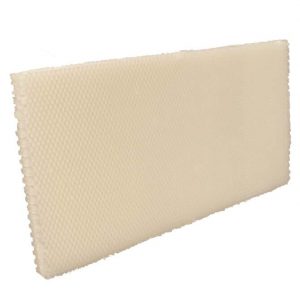
Available currently for deeps, BetterComb carries contamination concerns
Recently, a relatively expensive foundation featuring drawn wax (but NOT beeswax) cells that are synthetically produced has come on the market. Beekeepers should be concerned to see synthetic wax combs on the market.
Even if synthetic wax were chemically similar to beeswax and made of food- or pharmaceutical-grade ingredients, it is not beeswax. Using synthetic wax will degrade the quality of the products that beekeepers may give or sell to customers who expect a pure product made by bees. If the beekeeper does not acknowledge the addition of the synthetic wax, it could be illegal as well.
The synthetic wax combs are marketed as the solution to the perpetual problem of never having enough comb. They are for use in brood boxes and honey supers for starting new colonies, making splits, and preventing swarms. When used in honey supers, cappings will certainly be adulterated, but even if the combs are limited to the brood box, there is the potential to adulterate all the beeswax in the hive as the bees move wax around. This wouldn't be an issue if the material didn't mix with beeswax – but it does – and it has a similar melting range to beeswax.
This product may be geared to first and second season beekeepers who do not sell their wax, but many beekeepers want to expand in a year or two to comb or chunk honey or candles or personal care products. New beekeepers are encouraged to enter products into the county and state fair – how can they submit items containing wax from their hives if they use synthetic wax combs? If they decide to give up beekeeping, they may sell their hives to sideliners who are growing their apiaries and may reuse these combs. If beeswax containing synthetic wax gets sold to foundation suppliers, this product has the potential to contaminate the commercial wax supply.
The synthetic wax is advertised as a pesticide-free replacement to beeswax foundation or beeswax-coated plastic foundation in the hive. Beeswax absorbs chemicals that the bees bring in from the environment or from beekeeper applied miticides. While the synthetic comb may be free from pesticides when installed, it will absorb them from bee and beekeeper activity just as naturally drawn comb will. To prevent bee exposure to chemical buildup in comb, beekeepers are advised to rotate out brood combs on a 3 to 5 - year schedule, to use treatments that are not lipophilic, and to not apply treatments when honey supers are on colonies.
Beekeepers have the ability to use honey bee biology and correct feeding to draw out beeswax combs. New beekeepers can and should learn to get combs drawn – even honey supers started – their first season. Synthetic wax is a short-cut with questionable benefits and long-term consequences for every hive it is used in.
Randy Oliver has been in contact with the manufacturer and says that they are sensitive to our concerns that the beeswax supply will be adulterated. Randy suggested that they infuse the combs with a dye and make the information prominent that this wax cannot enter the beeswax rendering system. (Bee-L 1 Jan 2020)
In Europe, they are fighting adulteration of beeswax from imported foundation – why would we voluntarily adulterate our own supply?
As Randy Oliver said: "Our industry is based upon the perception of naturalness and purity. Manufacturers and beekeepers should keep that in mind." (Bee-L 3 Jan 2020)
by Deborah Hewitt
